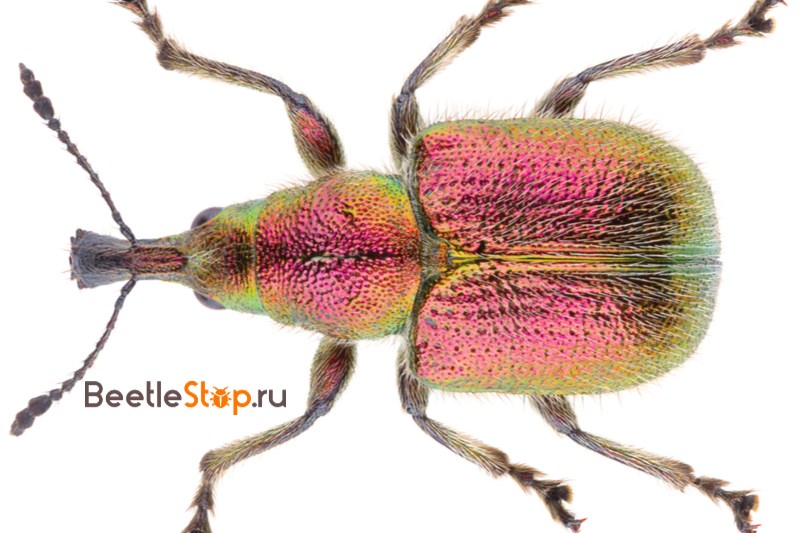Cherry Elephant - Long-Nosed Garden Pest
The pipelines family includes about 2 thousand species, half of which belong to the Bukarka subfamily. They are characterized by the development of offspring in the withering or decaying fruits of a feed plant. Cherry elephant is a typical representative of the family. Weevils are found on cherry, cherry plum, plum and cherry. Adults feed on buds and flowers, larvae develop in fruits. You can get rid of pests by shaking bugs to the ground, as well as by chemical treatment of trees.

Morphological description of the species
Cherry elephant or weevil (Epirhynchites (Rhynchites) auratus) is a beetle from the family of pipelines, the subfamily of bukarka, the genus of rhinitis. The length of the imago is 5-9 mm. The color is green with a golden and purple tint, metallic sheen. The head is small, shiny. The rostrum is purple, the apex is dark. A club-shaped antennae are located on it. The eyes are round, convex. Pronotum slightly convex, with constrictions at base and apex. Finely punctured surface.
Elytra almost rectangular at base and smoothly rounded at apex. There are longitudinal rows of large points. The whole body of the beetles is covered with bright protruding hairs. Wings are well developed cherry weevils actively fly in sunny weather.
Information. Two sharp spines on the pronotum allow distinguishing the male from the female.
Distribution area
Insects prefer regions with a warm climate. Cherry elephants are found in southern Europe, the Mediterranean and Central Asia.
Developmental biology
Beetles hibernate in soil or under plant debris dumped under fruit trees. Appear in the spring at the time of swelling of the kidneys. Adults are active in hot weather; they do not like moisture and coolness. They feed on buds, flowers, young shoots. Most often harm cherries. Two weeks after the start of flowering, trees begin to mate and lay eggs. The female gnaws the fetus to a soft bone, lays an egg on it. The passage closes the pieces that are gnawed from the surface of the bone.
Information. The size of the egg is 1-1.5 mm, the color is white, the shape is oval. Fertility of the female is 150 eggs.
After 1-2 weeks, larvae emerge from the eggs. Their white, arched body is covered with bristles. Legs absent, head brown with massive mandibles and short antennae. There is a scutellum on the pronotum; spiracles are located on the sides of the abdomen. Larva size 2.5 mm. It penetrates the bones and eats the contents. The development process takes 25-30 days. The adult larva leaves the fruit for pupation in the soil. She arranges a spherical chamber at a depth of 10-15 cm. Pupation of larvae occurs at different times. A part falls into diapause and pupates the next year.
Pupa 5 mm long, white, shiny. The body is covered with reddish hairs. The head with the rostrum is bent, at the end of the abdomen there are two sharp spikes. Another group pupates in the same year. Young beetles appear in May, after wintering. One generation of insects is replaced per year.
Methods of struggle
A massive outbreak of breeding among cherry elephants leads to the death of the crop, loss of foliage and drying of the trees. The damage threshold is considered damage to 15% of the kidneys.To prevent catastrophic consequences, comprehensive measures are taken to combat weevils.
Agrotechnical events:
- digging of near-trunk plots in spring and autumn;
- destruction of plant debris;
- whitewashing of boles with lime solution;
- collection and destruction of fallen fruits.
Mechanical way
In the early morning or in wet weather, when weevils are inactive, insects are knocked down by blows of poles along the branches. Previously, the soil under the trees is covered with plastic wrap or tarpaulin. Beetle harvesting begins in early spring before buds open. The procedure is carried out at least 4-5 times with an interval of 5-7 days. Collected insects are stoked in water or burned.
Trap device
One of the safe and effective ways to deal with the cherry elephant is to lay out hunting belts. They are made from straw soaked in insecticide. Belts are laid out around the trunks. Traps are cleaned after pests move into the soil for pupation.
Chemical treatment
Spraying trees with insecticides gives good results in the fight against beetles. It is recommended that the treatment with "Chlorophos" and "Karbofos" before flowering, after fruit set, repeated spraying is carried out. To exterminate pests helps dusting DDT crown and soil under the cherry. Treatment with a 3% suspension of DDT is also used. The crown and the stem of the trees are sprayed with organophosphorus compounds and neonicotinoids.

